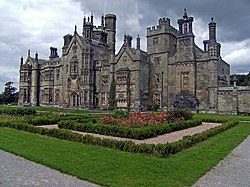Margam
| Margam | |
| Glamorgan | |
|---|---|
 Margam Castle | |
| Location | |
| Grid reference: | SS803854 |
| Location: | 51°34’28"N, 3°45’10"W |
| Data | |
| Population: | 3,017 (2011) |
| Post town: | Port Talbot |
| Postcode: | SA13 |
| Dialling code: | 01639 |
| Local Government | |
| Parliamentary constituency: |
Aberavon |
Margam is an ancient parish that forms a suburb of Port Talbot in Glamorgan, close to junction 39 of the M4 motorway.
History
Margam was an ancient community, formerly part of the commote of Tir Iarll, initially dominated by Margam Abbey, a wealthy house of the Cistercians founded in 1147. (Margam is believed to have played a significant role in the early transmission of the work of St Bernard of Clairvaux). At the dissolution of the monasteries, it came into the possession of the Mansel family who were eventually succeeded by their descendants in the female line, the Talbot family, a cadet branch of the family of the Earls of Shrewsbury.
The parish church continued to operate from the nave of Margam Abbey, as it still does. Margam Castle grounds contain the ruins of the Chapter House and major 17th century and 18th century monuments. The Stones Museum contains important evidence for the advent of early Christianity in the area.
With the coming of the industrial revolution, the parish of Margam became important for two reasons. First, it had a good harbour which was ultimately developed into Port Talbot, named in honour of the squires of Margam. Second, it had coal deposits, and coal mining in the parish took off in the late 18th century. The combination of local fuel and good transport links from the harbour made Margam an important part of the industrial landscape of the South Wales Coalfield.
At first, the coal workers lived away from the village of Margam itself, notably in a settlement at Taibach. However, eventually, the whole of the parish was submerged by the community of industrial workers. Margam then assumed its modern form as a suburb of Port Talbot.
Not included in the urbanisation and industrialisation of Margam, however, were the grounds of Margam Abbey, which were incorporated by the Talbot family into the grounds of their nearby 19th-century mansion, Margam Castle (badly damaged by fire in the late 20th century but now in process of restoration). The Talbot family had previously, in the 18th century constructed at Margam the longest orangery in Europe, which still stands. All the land was sold out of the Talbot family in the mid 20th century but it has been preserved as Margam Country Park, an estate of some 850 acres owned and administered by the local council which is a major local attraction. The collection of early Christian Celtic crosses and inscribed stones which the Talbot family had collected from the locality, were moved in 1932 into the nearby Church Schoolroom, to become the Margam Stones Museum, now managed by Cadw.[1]
In the early 20th century, Margam became the site of an important British Steel works.
Notable people
- The actor Anthony Hopkins was born at 77 Wern Road, Margam.[2]
- Peg Entwistle, the Broadway actress who jumped to her death from the Hollywood sign in 1932, was born in Margam in 1908.[3]
- Footballer Alan Durban grew up in Bracken Road, Margam.
References
- ↑ Sign boards at the Margam Stones Museum, undated, viewed in the Museum in June 2012
- ↑ Tiscali Film & TV: Anthony Hopkins Biography
- ↑ Page Title